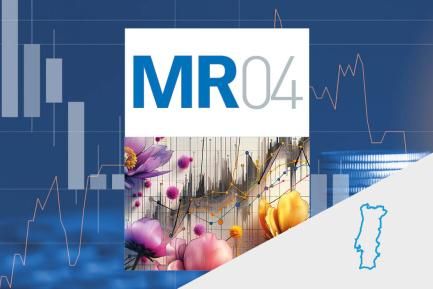
Inflation in Portugal: what risks await us?

- Inflation has been modest in recent years, and this weakness was accentuated in 2020.
- As pandemic-related effects are reversed in 2021, inflation will rise.
In Portugal, inflation has stood at around 1.1% over the last 10 years, well below the ECB’s 2% limit for the euro area. Moreover, core inflation, which excludes the most volatile components, has averaged 0.8%. This weakness in inflation intensified in 2020, but in early 2021 inflation began to rise. Does this upturn look set to continue?
2020 was an atypical year in many respects, and this was reflected in the behaviour of most macroeconomic variables, including inflation. In 2020, average inflation was 0%, having been in positive territory since 2015. The decline in prices was particularly significant in energy products (–5%), but the weakness in inflation was widespread across the board and core inflation also stood at 0%.
Much of the weakness suffered by inflation in 2020 can be explained by the impact of the COVID-19 crisis. To demonstrate its effect, we follow the methodology proposed by the Federal Reserve Bank of San Francisco1 to distinguish between the goods and services which comprise Portugal’s CPI that are «sensitive to the pandemic» and those that are not.2 The classification resulting from this exercise is presented in the first chart, which shows how during 2020 Portugal’s CPI was dragged down by the fragility of the prices most sensitive to the COVID-19 pandemic. We can therefore expect that, if the pandemic does not have persistent effects, the prices of these components will normalise.
- 1. See A.H. Shapiro (2020). «Monitoring the inflationary effects of Covid-19». FRBSF Economic Letters.
- 2. In the Focus «COVID-19 and inflation: a statistically significant impact» in the MR12/2020, we presented this methodology for inflation in Spain and in the euro area. Specifically, we stated that a component i is sensitive to the COVID-19 pandemic if the parameter β1 of the equation πt,i = β0,i + β1,i * COVIDt + ut,i significantly differs from 0. πt,i is the year-on-year change in the price of the component i, COVIDt is a dummy variable which takes a value of 1 starting from March 2020 and 0 in all other cases, and ut,i is the error term.

In contrast, 2021 began with a widespread surge in inflation in several EU countries. In January, the year- on-year change in the harmonised price index (which is more comparable across countries) increased by 1.2 pps in the euro area, reaching 0.9%. In Portugal, it stood at 0.2%, representing a notable 0.5-pp increase over the previous month, albeit a smaller rise than those suffered in Italy, France or Germany. In these countries, the main culprit was the postponement of the sales season, since this made the reductions in prices of items such as clothing and footwear less pronounced than usual. Moreover, in countries such as Germany, January’s inflation was also affected by the disappearance of the base effect of the VAT cut (a temporary cut which had been implemented in mid-2020 to combat the COVID-19 crisis but has already been reversed).
However, as the second chart shows, in Portugal the postponement of the sales seems to have had very little effect on the evolution of the prices of these items, which helps to explain why the rebound in inflation was less pronounced than in the euro area as a whole. That said, there is one factor which has helped to raise the price index in both the euro area and Portugal: the change in the relative weights of the items that comprise the consumer price index. To ensure that the set of products and services of the index remains representative over time, the statistical agencies update the relative weights of the various components each year, taking into account changes in consumption patterns. Thus, goods and services whose share of overall consumption grew in 2020 (heavily influenced by the COVID-19 pandemic) have gained relative weight in the set of prices. This weighting adjustment will push up inflation in 2021. As the third chart shows, the categories that recorded the highest average inflation in 2020 have seen their relative weight in the index increase. Thus, the change in relative weights generates a statistical increase in inflation: if those of 2020 had been maintained in January 2021, inflation would have stood at –0.24% (virtually unchanged from December). This impact will fade as consumption returns to patterns less distorted by the pandemic.

The higher inflation rates in 2021 should also be interpreted with some caution due to the influence of other transient effects. For instance, if the month-on-month change in prices were equal to the historical average (2001-2019) for the month in question, in 2021 there would be moments with inflation close to 2% (something not seen since 2012): the reason for this is the base effect of starting from the weak price level of 2020 (the so-called «yo-yo effect»). Furthermore, if all goes well then progress in the vaccination process will lead to the reopening of certain activities (such as travel, concerts, restaurants, etc.), which could cause local price volatility due to an increase in demand in excess of supply. On the other hand, the price of a barrel of Brent oil has recovered to its pre-pandemic levels, which will also generate inflationary pressures due to base effects (in contrast to current prices, slightly above 60 dollars, last spring a barrel of Brent had fallen below 30 dollars).
In short, 2020 was marked by the COVID-19 crisis and its downward pressure on inflation. In 2021, we will most likely see the reversal of those same events. Given the low starting point, inflation may suffer abnormal growth on some occasions, but this will need to be assessed with caution.



